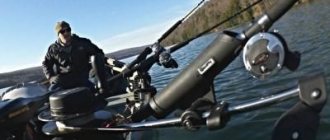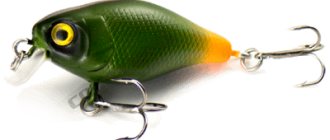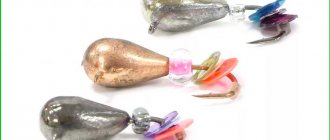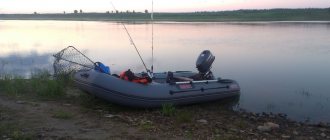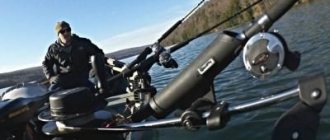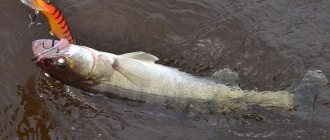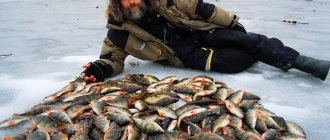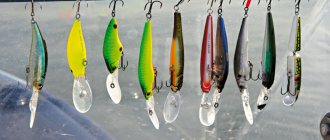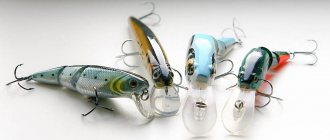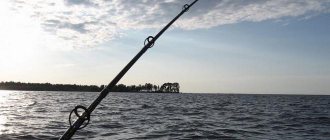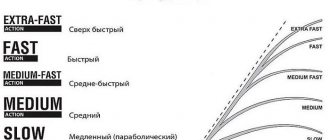Trolling fishing is one of the most effective fishing methods for catching large expanses of water. When trolling, the bait is towed on a fishing line behind a moving motor boat or speedboat. Trolling fishing is carried out for both marine and freshwater predatory fish. Trolling ensures good catches, including the capture of trophy specimens. What is trolling, where is it used, what gear and equipment are needed, what are the tactics of trolling fishing and how to look for potential prey is described in this article.
What is trolling?
The method of catching large fish using a watercraft equipped with an engine, in which the wiring is carried out due to the movement of the side, is called trolling. The essence of trolling fishing is as follows:
- To catch prey, retrieves are made while moving at low speed, feeding bait, as a rule, from several spinning rods of sufficient power, rigidly fixed in special racks.
- In order for the fishing density to be maximum and the gear not to get tangled, baits are supplied at different depths and at a certain distance from one another.
How to fish by trolling
Regarding trolling fishing techniques, it is worth paying attention to two main points of guiding baits along rivers. Wiring can be done both with the flow and against it. When choosing fishing tactics with the current, special attention is paid to the speed of the boat, which should allow the bait to play and not float freely in the water flow.
Important! The correct play of the bait is distinguished by the peculiar uniform rhythmic twitching of the quiver-type tackle, without any failure.
Driving baits against the current in selecting speeds is easier, because the animation of the simulator is achieved even with minimal movement as a result of the force of the water flow. In this case, an important parameter is the release length of the bait, which affects the depth of its stroke. During the reeling process, the angler must monitor the hooks, lowering the line in a timely manner and slowing down, and when reeling in the cords, pay attention to the trajectory of the bait, preventing the thread from getting on the motor propeller.
Trolling rod
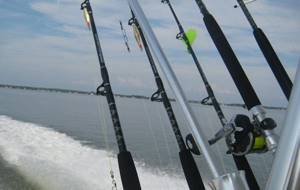
When trolling fishing, the sensitivity of the blank is not important, but its strength and reliability are important. Considering the specifics of this fishing method, you should opt for a powerful stick made from:
- fiberglass;
- composite material, which is a mixture of carbon fiber reinforced plastic (carbon fiber) with fiberglass.
Length
The length of the rod is chosen depending on how much gear will be used:
- when using one or two spinning rods, the optimal length of the blank is 1.8-2.4 m;
- if you plan to fish with three or more sticks, then they should be longer (2.7-3.3 m) to ensure spreading at the maximum distance and avoid entanglement.
Test

When determining the class of spinning rod according to the test, which shows the optimal weight range of the baits used, they take into account the fact that even the lightest of them can provide noticeable resistance when retrieving, and with increasing speed and depth it increases:
- If trolling is planned at shallow depths, use rods with dough from 15 to 50 g:
- average;
- medium-heavy.
2. For deeper fishing, take heavy tackle, with a dough of 50-80 g.
3. An extra-heavy blank with a test value of up to 200 g is mainly used for sea trolling, and very rarely for freshwater:
- in vast lakes;
- in the floodplains of very large rivers.
Build
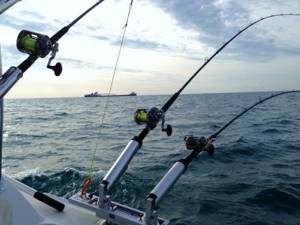
With the trolling method, self-hooking occurs, which requires sufficient rigidity of the stick. At the same time, the rod is subjected to extreme stress when biting and must withstand impacts along its entire length, which is achievable with a slow action - too rigid tackle in such a situation can simply break. In addition, when moving at high speed, the bait can be torn out of the fish’s mouth if a spinning rod with a fast action is used. The most suitable types of form for trolling:
- average;
- medium-fast, optimal when fishing the surface of a clean reservoir;
- slow, used for deep fishing.
You may be interested in: How to tie a leash to the main fishing line
Trolling line
The trolling line is selected depending on the size of the potential trophy. Braid is usually used because it provides clearer contact with the bait and has less resistance to flow. But it is worth considering that “braid” does not have the elasticity of monofilament, so for trolling it is better to choose slow-action rods to soften the blow during a sharp bite. River trolling speed is low - 2–4 km/h , and a monofilament shock leader is not required in the equipment to soften the shock. In sea fishing, such an element of equipment is required, otherwise the bait will fly out of the fish’s mouth.
Trolling reel
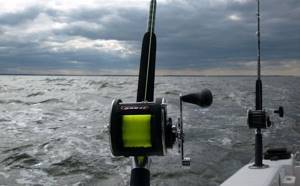
With this fishing method, certain requirements are imposed on the quality of the reel:
- it must be powerful and reliable enough;
- with a gear ratio of 1 to 3 or 1 to 4;
- with 4-6 bearings, one of which is used for the line guide;
- with a spool capacity of over 100 m of fishing line of the required thickness with a breaking load of 7 to 10 kg.
The clutch setting must exactly match the weight of the bait and take into account the fishing conditions.
Multiplier
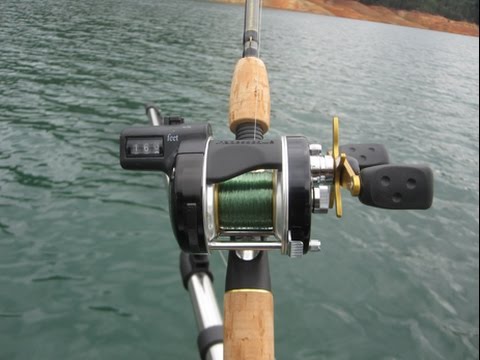
These reels are most often used for trolling fishing. They differ:
- simplicity of design;
- high power of movements during winding;
- the presence of a line counter in most models, which allows you to determine the distance to the bait and is especially important when fishing with several gears;
- the ability to select a model for the right or left hand.
Among the disadvantages, it is worth noting the difficulty of uniformly winding the fishing line in some models and the high cost. There are two main types of multipliers:
- Very powerful “barrels” that can handle any load. Among them there are models that can change the gear ratio when fishing conditions change.
- So-called “soap dishes”, which can be used at shallow depths to catch not too large specimens.
Inertialess
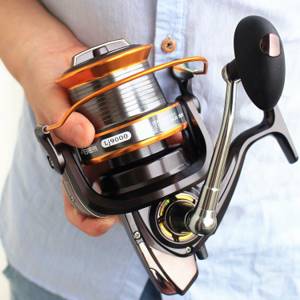
The choice of inertia-free fishing rods is justified for fishing at shallow depths:
- they have a lower cost;
- It is possible to disable the clutch and reel in manually, which helps when fishing for large fish.
Trolling tackle
The fundamental gear for trolling fishing is the spinning rod. Regardless of the types of trolling, a set of spinning equipment must have increased power that can withstand serious overloads. Excessive loads are not only associated with the occurrence of efforts when fighting massive caught fish and retrieving heavy deep-sea baits, but also arise from frequent hooks of fishing tools on underwater obstacles, which is considered an ordinary, working case in this area of hunting. Let's look at the main criteria for selecting a set of tackle from a more thorough perspective, focusing on each element separately.
Rod
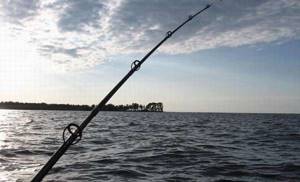
The material of a spinning rod for trolling must meet the requirements of strength combined with the properties of high plasticity. The weight of the rod for this method of fishing is not considered the most important criterion, because the fisherman does not constantly hold the tackle in his hands, but handles it periodically, which does not cause fatigue. Consequently, even blanks with reinforced winding rings made of fiberglass are quite suitable for the frame of the gear.
Length
It is inconvenient to use long tackle in a boat, so the optimal blank lengths are considered to be rods in the range of 2.3 - 3 meters. This spinning rod can be used comfortably when feeding and adjusting the course of the bait, as well as adjusting trajectories, avoiding obstacles that arise along the way.
Test
Trolling gear is selected with weights starting from 20 grams. This is the optimal value with which you can drive the wobbler in the surface water horizon, knowingly introducing the risk of unexpected hooks that seriously load the form. Practice shows that when hunting on small rivers, rods with a test range of 20–50 grams are suitable. When fishing in large rivers, lakes and reservoirs, 40–80 grams, and the sea direction of trophy production is carried out with gear with tests ranging from 100 grams and above.
Build
To ensure guaranteed self-hooking of pecked fish, the best results are shown by medium-fast and fast action gear. Slow blanks do not guarantee reliable hooking due to the softness and high degree of shock absorption of the material, which gives the fish a chance to escape, spitting out the bait weakened by the tension of the cord. Ultra-fast blanks increase the reliability of hooking, but easily break when hooked and a sharp bite from a fish.
Coil
In the configuration of tackle for trolling fishing, inertia-free traction and multiplier reels with large, capacious spools are used.
Important! In the design of the reel, special importance is attached to fine adjustment of the clutches, which helps preserve the rod and bait when snags occur.
When catching fish in fresh waters, reels starting from 3500 units are used. For sea fishing, it is preferable to install bulky multipliers with a line counter and a spool reserve of hundreds, or even a thousand meters. Recently, miniature multipliers have appeared on sale, suitable for trolling fishing in small reservoirs for small trophies.
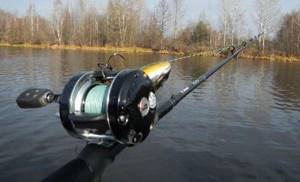
fishing line
The priority of equipment for trolling fishing is to install a non-stretch braided cord, which transmits the bite signal more clearly and quickly and takes up less volume in the spool, having high breaking load limits with smaller diameters. Multi-colored braided cords are comfortable for fishing; by the coloring of the sections, it is visually easy to determine the length of the unwinding of the tackle. Monofilament fishing lines, due to the high stretch coefficient and large diameters of the thread, are rarely used in trolling fishing and in very specific hunting conditions at short distances for carrying bait.
fishing line

For trolling fishing, a high-quality braided line is usually chosen:
- it has good contact with the bait;
- has twice the strength of monofilament.
For high-speed trolling on large bodies of water, the braided line is supplemented with a shock leader made of monofilament to eliminate the shortcomings of the line:
- poor elongation and inability to completely absorb production jerks;
- the possibility of rubbing the rings and the braid itself.
For rigid fast-action gear, use monofilament fishing line, which has good elongation, excellent springiness and will not tear the bait out of the mouth of the prey. The thickness of the fishing line is selected in accordance with the structure of the form:
- for the average one take 0.1-0.2 mm braid, and 0.3-0.4 mm monofilament;
- for heavy - 0.2 mm and 0.3-0.5 mm.
The breaking load limits must also correspond to those recommended for this fishing rod:
- if the upper value is exceeded, the stick may break;
- if the strength is too low, frequent breaks of the monofilament or cord are possible.
Considering the possibility of large pike biting, it is worth adding a metal leash about 0.5 m long to the equipment.
You may be interested in: Grayling
Trolling Basics
Trolling
There are several fundamental principles of trolling, regardless of which boat it is carried out from: a rowboat, a motorboat, or even an electric motor. The first is to use a rod holder. First, the rod holder should be firmly fixed in the boat, preferably permanently. It must securely hold the rod and at the same time provide the angler with quick access to it at the time of the bite. Simple holders can be made from metal or plastic pipes secured to the boat.
It is optimal to steer the boat in a slightly zigzag or curved course. Using two or three rods, this course recreates the natural situation where the bait on one side of the boat swims faster than the bait on the other side of the boat. Turns should be made slowly to prevent the lines from becoming tangled. In this situation, you can use from two to four rods.
The line should be released through a weak cast, or simply release the spool, and then the forward movement of the boat will unwind the line from the reel. When trolling, it is better to use short lines, but they must be of sufficient length to adequately cover the fishing area. Long fishing lines make it difficult to control the action of the bait. The vibration of the rod tip when retrieving means the bait is moving properly. In addition, it is better to hook with a short line.
Secondly, trolling with artificial bait from the bottom is that the line released should be 50% longer than the depth at which you are fishing. This length can only be increased if the water is crystal clear and the fish are shy.
It's also worth spending some time experimenting with different lures until you find the right one. After that, instead of all the others, use the “favorite” of the day. In some cases, a wide range of baits across the fishing depth makes trolling most effective. At other times, placing baits close to each other attracts fish to a greater extent, as it resembles a school of fry.
In windy weather, it is important to keep the fishing line close to the water so that the wind does not reel in the excess length. If the line is not tight, it is impossible to track the bite. To fully control the situation when the pike is already on the hook, you should reel in the remaining fishing lines before landing the caught fish.
Lures
Live bait is used extremely rarely as bait when trolling - preference is given to artificial options.
Wobblers
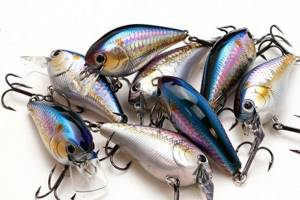
For trolling fishing, special wobblers are used, designed specifically for this type of fishing. High-quality baits of this type:
- excellent depth retention;
- have their own animation, which is set during uniform wiring and attracts the predator.
In shape and color, the wobblers should be similar to those fish that potential predatory prey usually feed on. Most Popular:
- Large and medium-sized sinking wobblers (divers), for which a downrigger can be used to deepen them. To successfully catch predators, baits with different working horizons are used on different rods.
- Cranky.
- Shed.
- Minnow.
Spoons

In addition to oscillating spinners, which work well for river trolling, the following are also used:
- heavy narrow vibrators, which can be lowered to a given depth without the participation of deepeners;
- Devons;
- castmasters;
- medium jigs;
- rotating spoons with a weighted lead head;
- specially equipped spinnerbaits.
Silicone baits
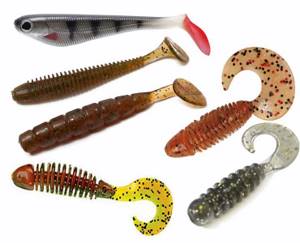
Long silicone fish used for trolling have a number of advantages:
- rarely give hooks;
- create an active game that attracts predatory fish;
- can be used at the optimal depth with a jig head of the appropriate weight.
The disadvantage of such baits is the low durability of the material. Taking this into account, offset hooks or mounted tees are passed through the body of the bait so as not to lose the prey.
Trolling fishing technique
Trolling fishing technique It's no secret that predatory fish very often stay in places where there is a pronounced difference in depth.
The fishing spots on the edges are quite difficult, so the best motor for trolling there would be an electric one. Silence, efficiency and good maneuverability will ensure high-quality fishing even on not very deep edges. As bait on the edge, it is better to use floating wobblers in tandem with a bouncer, which will eliminate unnecessary hooks and correctly set the depth of the tackle. An echo sounder will tell you the required fishing depth, and it is better to place the tackle from the bottom at a distance of 50 cm to 1 m. Trolling along vegetation requires good skills and knowledge of the bottom, but often produces record catches. In places where there is a lot of grass, hunting predators often live. It is better to place the bait on the surface or at shallow depths, so the silent boat engine plays an important role here. A shallow-water Magnum wobbler or its analogs is suitable for bait; you can also use medium-depth wobblers, but in this case you need to know well how far the vegetation rises from the bottom. Wiring the gear should not be carried out along the very edge of the vegetation. A hunting predator quite successfully attacks it even at a distance of 1 to 2 m from the edge of the grass. Wiring the tackle at such a distance from the vegetation will eliminate unnecessary snags.
When fishing in the middle of the river, especially in hot weather, you should take into account that the fish do not always stay near the very bottom. Sometimes you can catch a fairly large predator in the middle of the water. For trolling in such conditions, you do not need a silent and maneuverable engine, since in fast currents it is better to give preference to the power of the unit. When fishing against the current, good results are shown by jig heads and deep-water wobblers, such as Fat Rap Deep Runner, Shad Rap, Rattlin Rapala and Rattlin Fat Rap. The prefix Rattlin means that these wobblers are noise-making, which acts as an additional stimulating factor for attacking the bait.
Having caught pike perch while trolling in an open area, you should stop in this place and switch to spinning fishing. Once at the flock's camp site, you can successfully catch several more specimens using the spinning method.
Ambient temperature has a huge influence on the depth at which fish feed. Pike feels comfortable at temperatures from 14 to 20 degrees, and pike perch prefers even lower water temperatures. Therefore, the fishing gear should be placed at a depth where the temperature is most favorable for the predator. During the hot summer months, it is worth paying attention to places where natural underground springs exist. A microclimate is created near them and predators often hunt.
Depending on the depth at which you plan to fish, you should select a watercraft. For trolling on the surface and at shallow depths, the vehicles must be silent, and for strong currents - powerful. Therefore, it is difficult to say unequivocally which is the best motor for trolling.
Boat
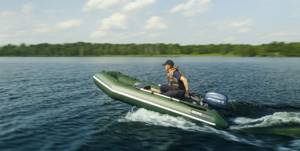
In small freshwater bodies of water and on small rivers, a boat made of:
- wood;
- plastic;
- metal;
- inflatable made of PVC.
The last option is different:
- mobility;
- compactness;
- ease of transportation.
Disadvantages include:
- danger of damage when fighting a large predator;
- impossibility of installing a powerful motor (this is not necessary for fishing in small water areas).
On large lakes and reservoirs, as well as for sea trolling, they use:
- special boats;
- boats.
Sea trolling
To troll in the sea, you will need a watercraft - a boat, a yawl or a reliable motor boat. Sea fishing by trolling is a specific, but interesting fishing. It is interesting because it gives hope for catching large, trophy fish.
The specificity lies in the fact that relatively short periods of active fight against fish can be interspersed with fairly long periods of waiting for a bite. And yet, the chance to catch something unusual pushes all the disadvantages of this fishing method into the background.
Trolling at sea is fishing that is carried out on a grand scale. Sometimes you have to pay long hours and many miles for an interesting bite. Although, if you are not picky in choosing a trophy, you can catch non-trophy fish without much effort.
For sea trolling, special trolling gear is used. These are powerful spinning rods with a minimum casting of 60 g, equipped with powerful spinning or multiplier reels and durable cords or fishing lines.
Artificial and natural baits can be used for trolling. At the same time, natural ones are more catchy, and artificial ones are more convenient. Traditionally, trolling uses spinners, wobblers and rigs with dead fish. With these baits you can catch all the predatory sea fish.
Engine
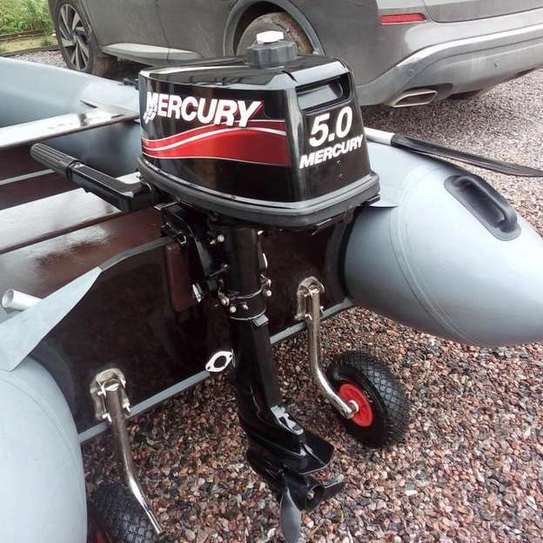
For trolling, low-power engines (2.5-3 hp) are used, which:
- consume little fuel;
- easy to maintain;
- provide an opportunity to calmly explore the body of water;
- work quietly at low speeds, without scaring away the prey;
- allow fishing at speeds of 2.5-5 km/h.
Special boats for trolling fishing, designed for fishing large areas at different depths, are equipped with stationary or outboard engines with high power, ensuring rapid movement of the craft to the fishing site, and trolling itself is carried out using an additional low-power motor.
Search for a predator
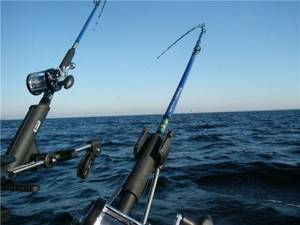
The search for predatory fish begins with reconnaissance, placing several baits at different depths, and then fishing the most promising places. There is a high probability that a predator will meet:
- where the shallows end and the depths begin;
- in the floodplains of small rivers;
- among coastal thickets;
- under snags;
- in whirlpools;
- in shallow waters where some individuals hunt;
- at great depths, especially with the onset of hot weather.
Fishing tactics

1. Fishing begins with the preparation of gear:
- they are loaded with baits;
- adjust according to fishing conditions.
2. Casting is done in a fan-shaped manner.
3. The forms are installed in holders, using deepeners if necessary.
4. Towing of baits is carried out at specified horizons, using an echo sounder.
5. Fishing begins from the deepest zones, moving slowly and using heavy baits.
6. Then they pass the dump 3-4 times, approaching from the side of clear water.
7. Next they walk along the thickets, trying to avoid snags.
8. When biting, as a rule, the prey is caught on its own.
9. Remove the stick from the holder and bring the fish to the side.
A careful approach to purchasing tackle and equipment for trolling, the correct choice of location and competent use of fishing tactics will not only ensure a successful fishing result, but will also enable the angler to fully enjoy the process itself, get a lot of unforgettable impressions and maximum pleasure.
